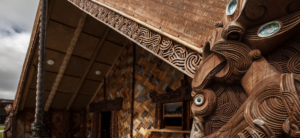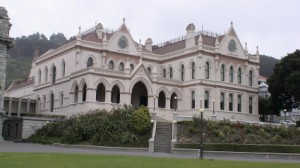In the end, at the urging of the government, the 1990 commemorations provided countless opportunities for New Zealanders to remember their histories of settlement since 1840, and the extent to which these memories had since shaped feelings of nationhood or ‘national sentiment’ within New Zealand.
The commemorations had encouraged the foregrounding of historical events which symbolised our continuing to reach for a ‘precarious maturity’, however indistinct, tenuous and fleeting those memories may have been.
Treaty as centrepiece
1990 also provided an opportunity for New Zealand to acknowledge the diversity of its multiple communities and peoples. The centrepiece of these commemorations was undoubtedly the Treaty of Waitangi and, at least by implication, the past and future of the Maori-Crown/Pakeha relationship. 1990 provided a ‘stock-take’ of that relationship.
Histories, exhibitions and public ceremonies produced stirring rhetoric but mixed results with many ordinary people still showing uncertainty as to the notion of ‘Maori as tangata whenua’ for New Zealand. And memories of England were still strong.
As the commemorations demonstrated, there was still an expectation upon Maori that was largely ceremonial and symbolic. But Maori not unreasonably wanted more. They had said so for some time, since the very beginnings of their participation in the nation’s development, especially in defence of a space where Maori customary tenets like iwi hapu and whanau remained legitimate; spaces like those provided by the Te Maori exhibitions.
Crown – Māori relationship
Beyond the public’s gaze, however, lay a different reality not entirely addressed by the year’s commemorations. As the Crown’s 1989 Treaty Principles made perfectly clear, severe limitations still remained in force as to the attainment of a Treaty relationship with the Crown which Maori had believed would happen when they signed the Treaty in 1840.
The Waitangi Tribunal was offering some relief as it grappled with key issues concerning Maori futures, but this was happening beyond the public and political gaze. Little could be achieved for Maori in this regard without the political will of the Government, and in 1990, beyond the rhetoric of commemoration, this was sorely missing.
The historical origins of this conundrum can be traced to the 19th century, beginning when Maori were first encountered by Pakeha before 1800 and extending to 1916 when New Zealand mourned its losses on the battlefields of Gallipoli, a remembrance of its war dead later formalised with the creation of Anzac Day in 1921.
Anzac Day 1921 also acknowledged our solidarity with Britain; we had fought with Empire and we had sacrificed our sons in defence of Empire.
Looking ahead
At least indirectly, sesquicentenary 1990 highlighted the process by which Māori people were precluded from the first stirrings of national sentiment, felt amongst Pākehā from the 1890s. It was also evident how detached Māori had become from Empire by 1914, or Empire detached from Māori – either way, Māori were not participants after 1921 as New Zealand sought to represent itself as an independent South Pacific representation of the best of England.
By 1990, much had changed for Māori, and for Pākehā. Not everyone thought that sesquicentenary would achieve much.
However, in looking back from 2020, across 30 years of intervening history, what we can say is that, in all of the commemorations, celebrations, community events, exhibitions, restorations and festivals, the groundwork was undoubtedly laid which, when taken on board, New Zealand would prosper communally, politically and, not least, culturally.
Sesquicentenary was a beginning.





